Does Cellphone Industry REALLY Pay Attention to Its Unintended Consequences?
This morning NBC's Today Show had a feature on the possible impact of smartphones on the rising teenage suicide rate. The piece was based on an Atlantic article entitled "Have Smartphones Destroyed a Generation?" which uses the above artwork. Coming the day after FCC adopted and released the Mid-Band NOI with glowing praise for all aspects of the cellular industry this reminds you blogger of a recurring theme here reflected in the title of this post.
( Based on Luke 12:48)
Yesterday's open FCC meeting shows how well the industry has captured the commissioners' near total attention with their glowing praise for a new inquiry into possibly new "commercial" spectrum bands between 3.7 and 24 GHz. While there was some slight parenthetical mention of unlicensed spectrum needs, NO other spectrum issues were mentioned. Indeed, the FCC's silence on any drone spectrum issue drones on respect drone policy being a key topic in DC for at least 2 years. Chmn. Pai's 2 parenthetical mentions of drones in old tweets appear to be the only statement any commissioner has ever made on the topic! Cellular spectrum is an important issue, but with the industry's urging it seems to have become the almost only spectrum issue that gets any attention at FCC, NTIA, and in Congress. Indeed, the industry's endless appetite for spectrum has resulted in a backlash at NTIA and within IRAC and all requests for sharing of federal spectrum are on a slow track there. Pending legislation on increased sharing/reallocation for cellular use make help that industry's near term problems, but will complicate all otters spectrum sharing as hostility in NTIA and IRAC increase. (The new delay requested by Sen. Cruz on confirming the next NTIA head is not helping!)
The industry is not only demanding fast track access to new spectrum by dominating the spectrum policy agenda to the near exclusion of all other issues - except perhaps NAB's pet issues on incentive auction costs and ATSC 3.0, it is also demanding both FCC ordering of quick local government consideration of all local approvals of new infrastructure along with a parallel campaign in state legislature to preempt most local government review of most new construction. Below is an example of such a new law in Arizona , although there are signs that similar legislative action is underway in many states.
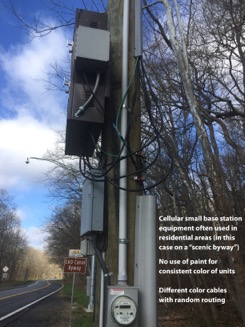
We have previously published posts that give several other areas of unintended consequences in which the industry has paid little attention to the impact of their technology and services. These include:
- Obnoxious use of cellphones in theaters and restaurants
- Contraband cellphones in prisons
- Safety issues of texting & driving
- Silence on drone spectrum issues
- Purchase of prepaid cellphones by the dozen by criminals without any identification
So while we agree that the cellular industry need more spectrum and that infrastructure construction needs more streamlining, the industry should also back off on being the center of attention and being unwilling to compromise with others acting int he public interest to meet its goals. Spectrum policy resources at both FCC and NTIA have been underfunded and will be more so under the 2018 federal budget. The cellular industry, along with most FCC regulatees has been silent on this continued underfunding and even nearly silent on the downsizing and undersizing of FCC spectrum field enforcement. Maybe the cellular industry should pay more attention to issues other than its immediate needs?
So cellular industry if you want to make your industry the center of both FCC and Congressional spectrum policy deliberations and always be first at the well for new spectrum, why don't you pay more attention to the unintended consequences of your industry such as those discussed above to show that you are responsible corporate citizens?
NY/NJ Bombings, Cellular & Public Safety: "Best of Times/Worst of Times"
However, we would like to point out another issue that is in preliminary news accounts: Several of the bombs involved had "flip phones" as part of them. Were these phones used like in Iraq/Afghanistan IEDs as a remote triggering mechanism? Too soon to tell from public sources. But this blog has been pointing out that unlike many other industrialized countries, the US has allowed unlimited sales of "burner"/prepaid phones over the counter with no documentation even as it has required some documentation for any Sudafed purchase to prevent diversion of that medication to crystal meth labs.
While there are valid reasons to allow some sales of prepaid phones without full documentation for battered spouses and others who are being unlawfully harassed, that does not mean you should be able to walk into Best Buy and purchase a dozen for cash without any record!
Those of us who travel overseas without corporate expense accounts and purchase local SIM cards requiring some identification for our unlocked US cell phones know it is not a large burden. But the US cellular interests seem to have had zero interest in this since prepaid phones are very profitable. On 12/27/11 we wrote here:
Unrestrained use of anonymous prepaid cell phones. Prepaid cell phones are a growing market and have many legitimate uses. One writer reports that “in 2009, in excess of 80 percent of new cell phone subscription growth came from prepaid service plans.” But nearly all the cell phones used illicitly in prisons and a major fraction of those used in crimes are prepaid “throw aways”.
Until recently, the largest prepaid operator, TracFone, allowed users to activate a phone bought anonymously and “skip” the step to report name and address. However, the option of buying with cash bagfuls of prepaid phones at Walmart, activating them over the web with a false name and address, and selling them for criminal use is still quite real. Isn’t it odd that we more concerned about over-the-counter sales of Sudafed and Plan B than we are about bagfuls of anonymous cellphones?
Many countries require some identification before prepaid phones can be activated. This is a complex issue both because of the size of the market and the appeal of prepaid phones to market sectors who need them for legitimate economic and safety-related reasons but, as we know from the voter ID controversy, may lack or be unwilling to identify themselves in the standard ways. While I sincerely hope we never have a cellphone-related IED attack in this country, such an event would force a PATRIOT Act-like knee jerk reaction that could be more draconian that a deliberate process now to address the situation.
Isn't it about time now to revise the issue of prepaid cellphones, also used greatly in prisons and by drug dealers, to come up with a reasonable set of registration criteria that does not hinder legitimate users?
Are Sudafed and nail polish remover really more dangerous than totally undocumented cell phones?
UPDATE
Later reports suggest that the flip phones used in these bombs were the power source and timer and that these bombs were not activated by a remote radio signal. There is no public information as yet on whether the phone were "burner"/prepaid or subscription/postpaid. But it would be a failure of the imagination to not wonder if the remote detonation capacity used in Iraq and Afghanistan by terrorists will arrive in the US.
There is anecdotal evidence in the DC area that for several years motorcades of VIPs have been sometime accompanied by a fog bank of cellular jamming - presumably to defend against this type of attack.
The Importance of Remembering to Use an Anonymous Burner Phone

In the US you need valid ID to buy Sudafed and related decongestants because they can be used to make crystal meth. You need an ID to buy large amounts of nail polish remover because it can be used to make explosives. But no ID is needed for cell phones. The lack of routine data on cellphones that would be available in other countries has resulted in DEA buying from AT&T access to the Hemisphere database that “covers every call that passes through an AT&T switch — not just those made by AT&T customers — and includes calls dating back 26 years”. So this policy does not protect privacy, it leads to more invasive law enforcement invasions of privacy.
For many years Tracfone was the largest provider of burner phones, perhaps it still is. Like all providers Tracfone requires some registration before a newly purchased burner can be used. But making up false names for dozens of burners can be such a pain so Tracfone allowed a shortcut for that market segment. See the last line in the signup form that used to be on Tracfone's website? "If you wish to skip this step, please click here"

(Formerly on Tracfone website)
But now Tracfone and others require you to at least make up a false name and address. Oh, for the good old days!
But "Affluenza" teen Ethan Couch, shown above, was apparently not as smart as your average drug dealer. He should have studied Breaking Bad more carefully! CNN reports that he was tracked down based on use of his cell phone. Ethan, making up false names and entering them on carriers' websites takes time, but it is worth it. Be thankful this is the USA. No one in the US requires ID to purchase even dozens of cell phones as opposed to Sudaphed and nail polish remover. Indeed, while Title VII of the USA PATRIOT Improvement and Reauthorization Act of 2005, P.L. 109-177 limits the amount of Sudafed you can purchase, there is no limit to how many cell phones you can buy at a time in the USA. Ethan, you should have stocked up on your way to Mexico!
But, Ethan, when you get back into a US prison you can be certain that genuine burner phones will be there for your use. They are the contraband phone technology of choice for incarcerated criminals! And since FCC is moving at a glacial pace in Docket 13-111, not to mention the petition filed by a large group of state corrections officials more than 6 years ago in July 2009, the burner phones you find there will probably work well. Even in isolated rural maximum security prisons the cell phone industry has convinced FCC than only a "silver bullet"-like quixotic technology yet to be finalized poses a low enough risk to their service that FCC could allow it to disrupt prisoners from running criminal enterprises or ordering murders of witnesses. (At least CTIA has removed from its website a video from a former high ranking official there that claimed, based on an incident in Brazil, that any prison cell phone jamming could disrupt cell phone services miles away!)
We sincerely hope that there is never a cellphone-activated IED attack on US soil. But we are certain that if this were to ever happen that the types of political forces that prompted the original PATRIOT Act would promptly require draconian limits on "burner"/prepaid phones. We hope that the FCC and the cellular industry have a rational contingency plan for doing this so that legitimate uses of prepaid phones by millions of users is not disrupted by the antisocial uses that the industry now condones. And if you have such a plan, why not phase it in now?
UPDATE
Lest you think I was too hard on Tracfone above, here is the first paragraph of Sean Penn's "El Chapo Speaks:A secret visit with the most wanted man in the world" from Rolling Stone:
It's September 28th, 2015. My head is swimming, labeling TracPhones (burners), one per contact, one per day, destroy, burn, buy, balancing levels of encryption, mirroring through Blackphones, anonymous e-mail addresses, unsent messages accessed in draft form. It's a clandestine horror show for the single most technologically illiterate man left standing.
(The spelling of "TracPhones" in the article says something about Rolling Stone's attention to detail which might also explain their mess with their UVA article on the fraternity party. But it is clear which carrier they are talking about.)
As Docket 13-111 Lingers Without Resolution, Comm. Pai Tries to Focus Attention on Prison/Cell Phone Crisis
Sobering meeting w/ corrections officials at Georgia prison about serious, growing problem of contraband cellphones. pic.twitter.com/Xbw3SRBCjm
— Ajit Pai (@AjitPaiFCC) October 16, 2015FCC Commissioner @AjitPaiFCC visited Georgia today to learn about the problem of cellphones in prisons. http://t.co/xI9eZq4c79 (from @AP)
— Kate Brumback (@katebrumback) October 15, 2015.@GA_Corrections: on pace to confiscate >8K contraband cellphones this year. Used to place hits, run scams, more. http://t.co/z8Ks8wgqq6
— Ajit Pai (@AjitPaiFCC) October 16, 2015Long time readers will recall that the issue of contraband cell phone use in prisons and countermeasures for dealing with them have been a recurring topic here, even if it is one that the cellular industry thinks should be buried. In general, communication should enhance life and usually does. But large scale use of contraband phones by incarcerated criminals actually threatens life!
Independent FCC action, championed by Comm. Clyburn, has reduced the cost of authorized legitimate pay phone services from prisoners to their families and has somewhat decreased the demand for contraband phones. On May 1, 2013, FCC released the NPRM in Docket 13-111 "to facilitate the development of multiple technological solutions to combat the use of contraband wireless devices in correctional facilities nationwide." This was almost 4 years after the filing of a petition for rulemaking by the South Carolina Department of Corrections and dozens of other state and local corrections agencies that apparently was consigned the FCC's secret petition black hole where it lingered in a corner of ECFS that was unknown to all but a few FCC insiders!
But as the cellular industry demands major changes for US spectrum policy to satisfy their endless appetite for spectrum below 6 GHz - they have only token interest in higher frequencies as can be seen in their minimal comments to FCC and participation in WRC preparation related to higher bands - as the cellular industry demands the lion's share of FCC's ever shrinking resources, they seem to have little or no interest in dealing decisively with this deadly unintended consequence of their present services. They have sent the underfunded and understaffed state and local prison administrators on a quixotic chase of the "holy grail": "managed access" which will solve the technical problem of illicit cellphone use in prisons with zero impact on the carriers' business plans. Indeed, they deny that this will result in any over coverage while at the same time insist that jamming will always results in over coverage. WOW - responsive physics!
In their most recent ex parte meeting with FCC staff in December, CTIA and carrier representatives pressed for "the need for a court order to terminate service to a contraband device" presumably under all circumstances including prisons in remote areas. Contrast this with the views of the American Corrections Association which ask to simplify the disconnect process, require carrier participation in managed access system if requested by prisons, and allow jamming in the location where it is technically possible due to remote locations.
But meanwhile nothing is being resolved at FCC in this life or death matter. Kudos to Comm. Pai for making an onsite visit to learn about the problem. We hope that FCC's delays in this urgent matter, now that 6 years have passed since the South Carolina petition, will soon end.
#IdeasForRandall
Or you can email all great ideas to me! I’ll take them on Twitter too! Just tag me with your idea & #IdeasForRandall http://t.co/uXenMnBfdv
— John Legere (@JohnLegere) October 13, 2015In the above tweet, T-Mo, "the Un-carrier" asks for comments on what is wrong with the industry. Perhaps we should all tell him that while the cellular industry has made many great contributions to US economic growth and US society, it has persistent blind spots with several unintended consequences of their actions and business plans.
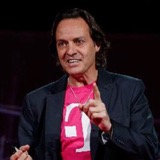
In response to a Tuesday morning report from the LA Times that an AT&T customer’s service improvement suggestions were met with a letter from the carrier’s lawyers, T-Mobile is encouraging customers from any wireless carrier to share their thoughts with the Un-carrier.
As of today, T-Mobile said wireless subscribers across the board are welcome to send their ideas for improving the industry to IdeasforRandall@t-mobile.com or share them with CEO John Legere on Twitter using the tag #IdeasforRandall. In its typical provocative style, T-Mobile said it will take action on the best ideas before forwarding them on to AT&T CEO Randall Stephenson and AT&T’s lawyers.
According to Legere, AT&T’s harsh response to Alfred Valrie, the longtime customer cited in the LA Times article, proves that AT&T and its CEO “don’t care about what customers want. AT ALL.” According to the LA Times report, Valrie received a warning letter from AT&T's lawyers after he emailed Stephenson suggesting the carrier offer "unlimited data for DSL users and 1,000 text messages for $10 a month."
“The entire Un-carrier revolution began by listening to customers,” Legere said in a Tuesday press release. “It’s where we get our best ideas, and I want everyone to keep sending them my way at John.Legere@T-Mobile.com. It absolutely amazes me that Randall would tell a lifelong customer to basically go away and talk to my lawyers. I interact with customers on a daily basis so I can hear their ideas firsthand. It’s called living in the 21st century.”
So, Mr. Legere, here are some ideas for your company and the industry to think about:
- The list of 7 New Year's resolutions I first posted in December 2011. These deal with: Wireless technology innovation, Social harmony and cell phone use,Cell phones use in vehicles, RF safety, Base stations and their environments, “Spectrum scoring” or “How to count to 500”, Provide communications for niche applications that otherwise contend for spectrum with CMRS, & Unrestrained use of anonymous prepaid cell phones. I don't see any progress or even industry interest in any of these topics.
- The lack of US cellular industry interest in 5G above 24 GHz. T-Mo filed comments in Docket 14-177 that were pretty useless and then didn't even file reply comments. How many of the 176 questions in the NOI did T-Mo address in their comments? CTIA & VZW filed also filed comments but no replies. Sprint didn't bother to file either! T-Mo's German parent takes R&D money from the German Government, a major stockholder, for millimeter wave 5G development. Is that related to T-Mo USA's disinterest in FCC policy developments in this technology?
- Why are T-Mo and the major carriers so disinterested in actually suppressing the use of contraband cell phones in prison? These phones have been used to run criminal enterprises as well as to order murders of witnesses. All the carriers seem focused on drawing a "bright line" on making ALL cellular jamming illegal through a twisted interpretation of 47 U.S.C. 333 and directing underfunded prison administrations on only "managed access" as a magical silver bullet when in some locations it really has the same problems. Many maximum security prisons are located in truly remote areas where the most cost-effective solution is carefully designed jamming with strict FCC rules on "over coverage". Cellular carriers have a bad state of denial on over coverage in managed access systems!
- Cellular carriers have been amazingly silent on spectrum policy issues of smartphone use in drones. Do you really want drones to use cellular spectrum for video downlinks? Ask your techies what happens when several drones fly at 1000' in an area where base stations were planned for users below 50'.
- Do T-Mo and other carriers actually support law and order in spectrum enforcement? When FCC decided to decimate its spectrum enforcement staff, the usually powerful CTIA and its members were very ineffective — only extracting a vague promise they would get attention. How much attention will you get from the remaining 44 demoralized agents spread across 50 states and Puerto Rico, especially if they don't get money for training, overtime, and travel to deal with complaints?
- Should cellular carriers support a more rational FCC budget appropriation for noncontroversial spectrum issues such as new technology and enforcement or just continue to demand a lion's share of the remaining resources and hope for the best?
- While I understand why T-Mo and other carriers charge large roaming fees in many cases if you use a US cell phone overseas without making arrangements for a special plan, I do not understand why if you call an overseas number from a cell phone operating in FCC jurisdiction you are charged a per minute rate that approximates the former AT&T's 1970s tariffs of several dollars a minute when the fair market value of an international call today is less than $0.10/minute. Don't such extremely high charges violate Section 201(b) of the Communication Act and are a sign of market failure?
Mr. Legere, next time you are passing through the DC area, I would be glad to meet with you to discuss these issues. Your DC staff knows how to find me.
UPDATE
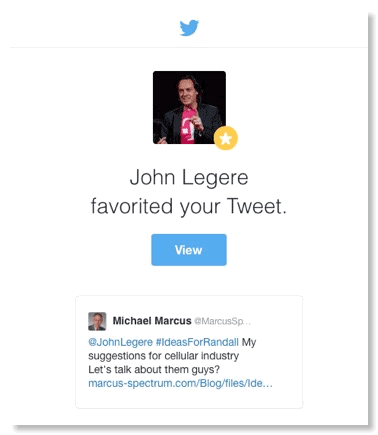
Another Obnoxious Use for Cellphones: Smartphone Use in Movie Theatres

Textual healing
Roger from Great Falls, Va., said that a new year is a good time to remind people not to look at their cellphones during movies. “Taped requests prior to the movie are useless since the offenders already have their faces buried in their screens at the time,” he wrote. “A crowded theater looks like a flock of fireflies just from the LED lights, as emails are checked throughout the movie.”
Sure, Roger, I’ll mention it, but I don’t think it will do much good.
I’ve written about this in the past. Back then, I didn’t think theaters were quick enough to add admonitions against cellphones before the movie started. To their credit, they finally did. Then there was a period when people seemed to sort of get that it was rude to text during a movie.
But now we’ve emerged out the other end, into a time when cellphones are so ubiquitous that half the people who look at them during movies probably aren’t even aware of it. People don’t stop texting when they’re hurtling down the interstate. Why would they stop when in a movie theater?
Roger wrote: “I’d bet that a theater that can block signals would be a big draw. Heck I’d pay a premium for that. In the meantime it looks like Redbox is the only option.”
Theater owners hate to hear that. But they don’t seem willing to invest in the bodies that would stop texting, like an usher at the back of each auditorium looking for cellphone scofflaws.
My only suggestion is to patronize theaters unlikely to attract texters. I think I’ve seen a cellphone out at the AFI Silver only once. The Landmark cinemas on E Street and in Bethesda are great because their auditoriums are underground, unable to be penetrated by cellphone signals.
Of course, they tend to show small, independent films, so if you want to see a blockbuster you may have to sit in the front row, where you’re sure to have only one glowing screen in front of you.
Of course, this is not the first time this problem has been recognized in the blogosphere: National Review, Screen Rant, Today Show. There is even a post in the Houston Press blog advocating more cell phone use in theaters - another reason not to move to Ted Cruz ’s and Rick Perry’s Texas where the theatre patron next to you may well also be armed.
While the cellular industry demands the focused attention of the spectrum policy community on their ever growing spectrum needs, where do they stand on this issue? I can find nothing relevant on CTIA’s voluminous website. Indeed, the industry is silent on many unintended impacts of their technology except to occasionally deny them.
But why can’t the cell industry both ask for more spectrum and try to clean up some of the problems it has created? Maybe the solution is technical, maybe it is better user education, but why not at least try and heed the advice of the Don Norman report?
Jammer Enforcement Actions at FCC
In the above “landmark enforcement action” FCC issued a Notice of Apparent Liability(NAL), i.e. a fine, against a Chinese jammer company for marketing in the US by way of Internet and some unidentified shipping mechanism, “285 different models” of jammers targeted at cellphones, GPS, Wi-Fi, Bluetooth, etc. The amount of the proposed fine is $34,912,500! However, none of this goes to FCC and it is unlikely that any of it will ever be paid in any case.
Lest you think this is the only Chinese company doing this, your blogger has received dozens of e-mail ads for such devices from a different firm and has routinely forwarded them to FCC/EB. So clearly C.T.S. Technology is not the only offender.
Para. 5 of the new NAL states
“We also again warn U.S. consumers that importing a cell, GPS, or other signal jammingdevice (i.e., purchasing such a device online and having it shipped into the United States via the U.S. mail or other transport or courier service) is unlawful and may subject them to civil and criminal penalties.”
This is followed by a citation to fn. 4 which cites 18 U.S.C. § 1362 and 18 U.S.C. § 1367(a) as well as the 2010 Phonejammer.com FCC NAL. The only problem is that the 2 cited laws have nothing to do with ordering jammers - they deal with actually jamming a federal communications system or a communications satellite - something unlikely with the jammers involved here, but remotely possible. (The cited Phonejammer also has nothing to do with ordering jammers.) So was this section of the NAL sloppy legal work in EB or is there a legal ambiguity under present statutes on the issue of importing jammers for personal use? It is clear that § 333 forbids actual jamming of licensed/authorized transmitters:
No person shall willfully or maliciously interfere with or cause interference to any radio communications of any station licensed or authorized by or under this chapter or operated by the United States Government.
The cellular industry prefers to read § 333 as forbidding FCC from ever authorizing any jamming, even in remote prisons. Thus they were successful in stopping FCC from even asking for public comment on the GTL petition on both jamming and “managed access” - notwithstanding the § 1.403 requirement to issue “promptly” a PN asking for comments on such petitions. They even managed to get FCC to draft the Docket 13-111 NPRM to exclude any discussion about what is the scope of § 333 even though this rulemaking is partially responsive to the GTL petition.
The cellular establishment is betting that its interpretation of § 333 will be able to drive all jammers from US territory. However, as we have stated repeatedly, there is a demand for jammers that arises from perceptions of antisocial use of communications. While there are some possible uses of jammers that are beneficial financially to the perpetrator of such use, (e.g. a hotel owner jamming cellphone to force use of expensive hotel room calling services), in practice such use is very rare. Most cellular jamming and GPS jamming is in response to perceptions of antisocial behavior or invasions of privacy. Until the cellphone and GPS industry address those perceptions about the harmony of using their products and the impact on others there will always be consumer demand for jammers. Discussing nonexistent laws that ban consumer ordering of jammers, as in para. 5 of the NAL, or banning all prison jamming use under a specious interpretation of § 333 may feel good to the cellular industry, but are doomed to be ineffective.
Hopefully this NAL might spur Customs and Border Protection to try harder to intercept jammers on their way to the US and might spur carriers like FedEx to ask more questions from shippers like C.T.S. Technology.
UPDATE
Our friends at CommLawBlog, who actually are lawyers when not blogging, also have questioned the legal basis of this NAL stating:
We also can’t help questioning the extent to which C.T.S. actually violated the law.
True, it shipped ten devices to U.S. addresses, but it performed its acts in China, where it may be perfectly legal to ship jammers to U.S. addresses. One unquestionably unlawful step in the transaction was the importation of the ten devices – but FCC staffers, not C.T.S., did that by initiating the transactions and accepting delivery.
Penalizing C.T.S. for the 275 models that it advertised but did not ship to the U.S. is even more tenuous. There is only one Internet; a company cannot easily promote its products on line in some parts of the world but not others. The FCC’s best arguments are probably that (a) some of the advertised products jam wireless frequencies used only in the United States and (b) the company quotes prices in U.S. dollars. True, C.T.S. could refuse to fill U.S. orders and could display a notice on its website stating that policy. But the failure to have the policy and to display the notice may not add up to an actionable violation.
To be clear: C.T.S.’s jammers are disruptive and potentially dangerous. We agree with the FCC that they have no place in the United States. We fully support the FCC’s efforts to keep them out of the country. We just wish the FCC could manage it from a more secure legal platform.
So if the goal is to actually stop the sale and use of such jammers in the USA, not just to posture to the cellular industry, perhaps some more pragmatic actions are needed.
Cellphones on Airplanes: Round 2
§ 22.925 Prohibition on airborne operation of cellular telephones.
Cellular telephones installed in or carried aboard airplanes, balloons or any other type of aircraft must not be operated while such aircraft are airborne (not touching the ground). When any aircraft leaves the ground, all cellular telephones on board that aircraft must be turned off. The following notice must be posted on or near each cellular telephone installed in any aircraft:
“The use of cellular telephones while this aircraft is airborne is prohibited by FCC rules, and the violation of this rule could result in suspension of service and/or a fine. The use of cellular telephones while this aircraft is on the ground is subject to FAA regulations.”

Yesterday, 11/22, the NY Times reported that Chmn. Wheeler is clarifying his views on the cellphone on airplane proposal that he had announced the previous day. Here is the full statement:
“Yesterday we announced a Federal Communications Commission (FCC) proposal that recognizes that there is no technical reason to prohibit mobile devices from interfacing with the onboard wireless data systems being installed on many aircraft. If the Commission adopts this proposal after the public has had the opportunity to comment it will be only a technical advisory, an update to our rules. There is nothing in the proposal that prohibits airlines from developing whatever in-flight phone usage policy they may wish.
“The job of the FCC with respect to this issue is limited to issues related to communications technology. Technology is available and being deployed today on flights outside the United States that permits use of mobile devices on planes without causing interference to cell phone networks on the ground. These advances in technology likely no longer warrant – on a technological basis – the prohibition of in-flight phone use with the appropriate on-board equipment.
“We understand that many passengers would prefer that voice calls not be made on airplanes. I feel that way myself. Ultimately, if the FCC adopts the proposal in the coming months, it will be airlines’ decisions, in consultation with their customers, as to whether to permit voice calls while airborne. The European Union has had a similar policy since 2008. That experience has demonstrated that it is possible to adjust the on-board communications equipment not to handle voice traffic, thus effectively shutting down any calls.
“We believe that airlines are best positioned to make such decisions. For this reason, our proposal does not impose any requirement that airlines should provide voice connectivity. We encourage airlines, pilots, flight attendants, and the public to engage in our upcoming rulemaking process.”
In order to add some facts to this discussion, we have place at the top of this post the actual present FCC rule which probably goes back to the beginning of cellular in the early 1980s. Note that it forbids the use of cellphones “aboard airplanes, balloons or any other type of aircraft” thus it is not focused on protecting the aircraft’s avionics which was the rationale for the FAA’s Kindle ban that was reversed recently.
While cellphones worked on aircraft on 9/11, use of basic cellphone technology from a high altitude, be is an airliner, a Piper Cub, or a balloon creates real problems for the terrestrial cellular system and this was the rationale for the original rule. At altitude such a phone illuminates many cell base station, either causing interference in many cells or tying up extra spectrum assets. However, today we have new technical options as Chmn. Wheeler alludes to: very low power picocells or femtocells can provide service to cellphones on the plane on standard cellular spectrum. Today’s cellphones, unlike the first generation, have a very complex transmitter power control system under the control of the base station the phone is communicating with. With the resulting use of very low power by both the consumer cellphones and the plane’s picocell or femtocell there is no impact on the terrestrial system and hence the original rule is not needed and could be replaced with a complex rule that stipulates how much power can be used and under what circumstances. (Note - the communications between the picocell/femtocell and the ground must be done on a noncellular frequency such as the longstanding “Airfone” spectrum or a satellite system.)
In the FCC Blog, Roger Sherman, Acting Chief, Wireless Telecommunications Bureau states
As the expert agency on communications, it is the FCC’s role to examine how we regulate the industry, and address unnecessary regulations when possible. In this case we have an outdated rule on our books that has been overtaken by advances in technology. If the technological justification for our existing prohibition is no longer valid, then it is our responsibility to examine ways to update and modernize the rules through an open and transparent rulemaking process.
I fully agree with this general concept.
The technical rationale for §22.925 no longer exists as Chmn. Wheeler stated and as I discussed above. BUT this is not the only technology that is forbidden by an anachronistic FCC rule. Why should this be an immediate priority? There appear to be no petitions requesting this change, while there are other technical petitions in FCC’s petition black hole that have sat without action for literally years. Indeed, it is hard to find anyone even advocating this change!
As I have discussed in the context of the history of Wi-Fi, that ubiquitous system came about from a directive from Chmn. Ferris to actively search for technologies being held back by anachronistic restrictions and to “free” those technologies so they could sink or swim in the marketplace on their own merits.
Now the marketplace for Wi-Fi technology is very different than the marketplace for cellphones on airplanes. Especially after the recently approved American/USAir merger there are fewer and fewer airlines these days and they are desperately searching for ways to extract more fees from passengers.
I strongly support the Commission searching for anachronistic technical restrictions and freeing technology to serve the public. That is what brought us Wi-Fi and that is what brought us the new WiGig 60 GHz technology for wireless connections of video in the home. But the FCC clearly has limited resources and the next year’s deliberations on the incentive auction and the transitions from analog telephony will be very time consuming for FCC leadership and staff. Shouldn’t FCC consider a wide variety of obsolescent regulations for review and prioritize them according to factors such as long term benefit to society and the economy?
If they can’t think of anything else more productive than cellphones on airplanes, they might want to start with ending the current prohibition on all nonexperimental spectrum use above 95 GHz.
Cellphones on Airplanes:
Here We Go Again!
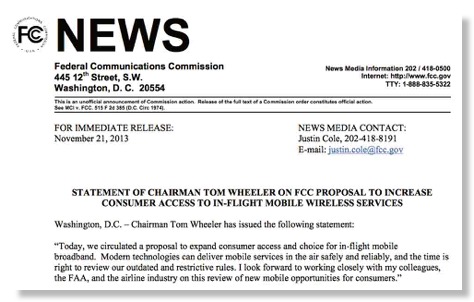
As the Commission approaches 2014 with urgent and critical decisions on IP replacing analog telephony and the incentive auction, it is puzzling that it suddenly want to consider the res judicata issue of cell phone use on airplanes. (Note this is not literally cellphone use on airplanes since use of a full power cellphone at high altitude hits many different cells and ties up significant cellular capacity. The system talked about is the system now used in Europe with essentially a low power femtocell on the aircraft that is connected to the ground via satellite or a noncellular air-to-ground frequency.)
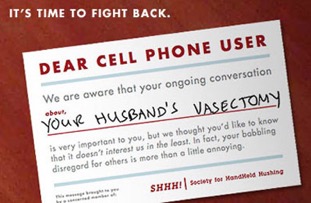
Because the Commission considered this very issue in Docket 04-435, 9 short years ago. Officially, that docket was terminated without a decision because
But a quick review of the record shows that 8,123 (!!!) comments were filed (a large number for EMC issues) and most of them they deal with other than electromagnetic interference issues. Here is a typical comment filed:“(t)he comments filed in response to the NPRM provide insufficient technical information on whether the use of cellular phones onboard aircraft may cause harmful interference to terrestrial networks.”
The AP article on the FCC’s rejection of the proposal was clearI heard on the radio that the FCC is considering allowing cell phone usage on planes. I most urgently beg you NOT TO DO THIS, in the interests of public safety.
If the cellular industry want to have more cellphone use in places where it presently is missing, you blogger humbly suggests they do something about making such use LESS OBNOXIOUS as was made clear in the comments 9 years ago. Here is some guidance from the manual of a cell phone sold in Japan. Even see this in a US cellphone manual or advertising from a US carrier?Striking a blow for cell phone haters everywhere, a government agency on Tuesday said it will keep a rule in place that requires the divisive devices to be turned off during airline flights.The reasoning behind the decision was technical. But the avalanche of comments the Federal Communications Commission has logged from airline travelers have been nothing short of visceral.
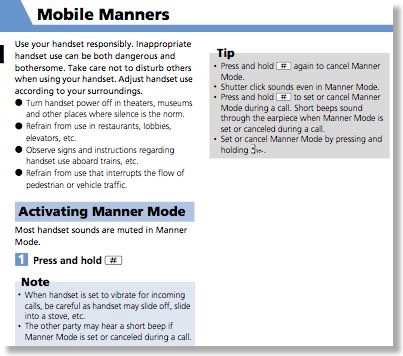
From the manual for a cellphone sold in Japan
We would also urge the industry and proponents of cellphone use in aircraft to review the 2005 study Motorola commissioned study by Don Norman on “Minimizing the annoyance of the mobile phone: The Annoyance, Irritation, and Frustration of The Mobile Phone -- A Design Challenge” and seriously consider Mr. Norman’s recommendations that seem to have been ignored so far.
Cellular technology can add a lot to our society and economy but when poorly designed and promoted it can also contribute to both antisocial use and social friction. The social friction resulting from much current cellphone use, we believe, was the cause of the Docket 04-435 backlash and will continue to be the case unless industry starts addressing it as Japanese industry has.
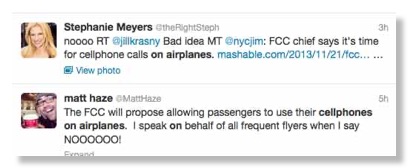
Initial Twitter response
Tip O’Neill, mentor of Chmn. Ferris, famously said “all politics is local”. This is why this initiative is doomed unless the industry “wakes up and smells the coffee”.
Doesn’t the industry ever wonder why people want to jam their product? Let me give them a hint: hotels might have a financial incentive to jam cellphones to get guests to use overprice phones in their rooms. But this is not a problem in practice. Illegal jamming by private parties is generally addressing obnoxious or unsafe uses of cellphones.
Cecilia Kang reports in the Washington Post, “FCC sees backlash after proposing to allow in-flight cellphone calls on planes”, that there is someone who actually likes this proposal.

Visit NBCNews.com for breaking news, world news, and news about the economy
UPDATE
If you want an alternative viewpoint, here is “The FCC should get out of the way of cellphones on planes” by Stephen Stromberg, an oped from the Washington Post
I contacted CTIA and asked if they had a statement on the issue, the response was “We do not have a statement.”
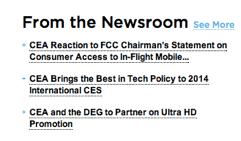
UPDATE
“CEA Reaction to FCC Chairman’s Statement on Consumer Access to In-Flight Mobile Wireless Services” is now available on the CEA website. In it Julie Kearney, vice president of regulatory affairs and Doug Johnson, vice president of technology policy of the Consumer Electronics Association (CEA)®, are quoted as saying:
“Of course, any liberalization of the use of wireless devices on airplanes should not negate general common courtesies. Engaging in phone conversations in flight may prove technically feasible but many may find it socially undesirable…CEA has always held this view and urges airlines to exercise good judgment. All stakeholders should work together to ensure that passengers continue to enjoy comfortable air travel, if voice communications are permitted.”
We congratulate CEA on addressing issues that are “socially undesirable” and hope that the mainstream cellular industry also addresses the social implications of today’s cellular use.
Also to be perfectly objective, the Washington Post on 11/24 published an editorial entitled “The FCC makes the right call on cellphones on planes”. The Post writes
“The immediate impact of the FCC ridding the country of its unnecessary rule, then, may well be small. Yet we hope that carriers explore their options to bring air travel into the 21st century, with all its pluses and minuses. While some passengers mourn the disappearance of their last disconnected refuge, others will embrace the convenience of connection. Either way, there’s no reason for the government to play referee.”
State AGs to cellphone makers: Install technology to curb thefts
Visit NBCNews.com for breaking news, world news, and news about the economy
NBC Today Show’s Jeff Rossen did a segment this morning on a move by 31 state attorneys general to send letters to “leading cellphone makers Samsung, Motorola and Microsoft demanding the companies ‘take all steps necessary to put consumer safety and security ahead of corporate profits…’ “
The 29 states and two territories signing the A.G.'s letter are Arizona, Arkansas, Connecticut, Delaware, Florida, Guam, Hawaii, Illinois, Indiana, Iowa, Kentucky, Maine, Maryland, Massachusetts, Michigan, Minnesota, Mississippi, Missouri, Nebraska, Nevada, New Hampshire, New Mexico, New Jersey, New York, North Dakota, Oregon, Pennsylvania, Puerto Rico, Rhode Island, Utah, and Vermont.
Microsoft has already said:
“Windows Phone has built in capabilities enabling users to find, lock and even remotely delete data from a lost or stolen phone. We agree this is an industry-wide issue and are working closely with the CTIA and other organizations to address.”
Rossen gave Apple good grades for a feature built in to their latest operating system to “brick” phones although he complained it was somewhat hard to find.
CTIA does have information on links to suppliers of antitheft software. Their main page of information on the topic, Before It's Gone: Steps to Deter Smartphone Thefts & Protect Personal Info, has the statement “CTIA and its members remind you that your personal safety, not your smartphone, should always be your number one priority.” However CTIA carefully avoids the issue of violent smartphone thefts that seem to have motivated the AGs action and appears to focus on protecting the information on the smartphones through remote wiping. The issue of “bricking” phone to make theft unattractive and hence decrease violence.
This is typical of a cellphone industry trend to minimize the unintended consequences of their products, be they
- RF safety concerns or
- use of cell phones in prisons or
- anonymous cellphone use by criminals
- or the “uglification” of communities with cell towers that were designed with no attention to their environment
Video from CTIA website - Note being mugged is not given as one of the “stages of losing a cellphone” and the woman that lost the phone does not appear to have any injuries - unfortunately not always the case!
Other coverage:
NY Daily News
Mass AG
Village Voice
UPDATE
On December 30, 2013 FCC Commissioner Pai tweeted:
A gun-toting mugger in Central Park was so disappointed by his victim’s cheap flip phone that he handed it back." http://nypost.com/2013/12/29/central-park-mugger-rejects-flip-phone/ …
This is one of the realities that the cellular industry is trying to ignore: If you make use of smartphones in urban areas dangerous because they are too valuable to thieves since they can’t be “bricked” readily, urban users may go back to “flip phones” and “feature phones” and avoid the highly profitable but possibly dangerous smart phones.
Thus bricking phones quickly and effectively is really in everybody’s interest!
The Societal Cost of Unrestricted Sale of Burner Phones
However, if at the same Walmart you want to buy Sudafed you will find that the law allows for the sale of pseudoephedrine only from locked cabinets or behind the counter. The law also:
- limits the monthly amount any individual could purchase
- requires individuals to present photo identification to purchase such medications
- requires retailers to keep personal information about these customers for at least two years after the purchase of these medicines.
As we wrote last month, CVS is voluntarily beginning to limit - not forbid - sales of nail polish remover because the acetone in it is also key to the crystal meth production process. However there is no sign that they are limiting sales of “burner” phones.
In its reply comments to Docket 13-111 on wireless devices in prisons, Verizon Wireless commented on “brier” phone restriction issue. This is the first time we are aware that CTIA or any of its major members has publicly addressed the feasibility of restricting sales of “burner” phones. VZW told FCC:
One commenter suggested that the Commission consider placing requirements on the type of information and the validity of information carriers obtain in providing service to customers purchasing prepaid devices. MSS Comments at 13-14. See also Indiana Department of Corrections Comments, GN Docket No. 13-111, filed July 17, 2013 (“Indiana DOC Comments”) at 1 (questioning whether selling such devices to anonymous persons is desirable public policy). While MSS acknowledges the legitimate need of some users, such as battered spouses, to obtain such devices anonymously, it urges the Commission to consider requiring identification validation for at least some purchasers of prepaid devices. Given that such a requirement would necessarily impact users other than contraband device users, this suggestion is beyond the scope of this proceeding and should not be considered in this docket.
So VZW feels that since restrictions might impact some legitimate users, we should not even think about restrictions that may have a balance of pluses and minuses. As can be seen in the picture at right, VZW at one time even used vending machines to sell “burner” phones! If Congress had similarly thought that the need of the public to buy Sudafed outweighed the benefits of preventing deaths through methamphetamine abuse, then we would not have the “burdens” we face in buying Sudafed today. Had only the Sudafed makers been represented by CTIA we might be able to find Sudafed vending machines on street corners for the convenience of those with a late night case of a runny nose!
But a September 1 NY Times article entitled “Drug Agents Use Vast Phone Trove, Eclipsing N.S.A.’s” reveals another cost of the unrestricted sale of burner phones. The article describes how AT&T sells to DEA access to “Hemisphere” - a huge database of “metadata” about the phone calls of Americans. As opposed to the NSA database, Hemisphere “covers every call that passes through an AT&T switch — not just those made by AT&T customers — and includes calls dating back 26 years”.
Why does DEA needs such a comprehensive, and no doubt costly system? The article goes on to say:
The Obama administration acknowledged the extraordinary scale of the Hemisphere database and the unusual embedding of AT&T employees in government drug units in three states.But they said the project, which has proved especially useful in finding criminals who discard cellphones frequently to thwart government tracking, employed routine investigative procedures used in criminal cases for decades and posed no novel privacy issues. (Emphasis added.)
Thus because the cellular industry is not willing to consider any compromise to the unrestricted sale of “burner” phones we must live with a large invasion of privacy by DEA and its state and local partners and the potential abuse of this information. It appears that AT&T has even turned this into a new secret, but presumably profitable, product line!
Wouldn’t modest regulations on “burner” phone sales, perhaps similar to the above stated DEA rules on Sudafed sales, be a more reasonable balance of public interests? If there is ever a cell phone triggered IED incident in the US, there will be a large outcry for such regulation and the outcome will not be as moderate and balanced as what would be feasible today in a less frantic atmosphere. We urge the initiation of a deliberate dialogue on this topic to balance all legitimate needs. Do we really need unrestricted sales of bags full of anonymous prepaid “burner” phones?
Nail Polish Remover & Cell Phones
Almost 2 years ago we wrote here, “Isn’t it odd that we are more concerned about over-the-counter sales of Sudafed and Plan B than we are about bagfuls of anonymous cellphones?” While cellphones are generally a product with positive social impact, the special case of anonymous “burner” phones is more questionable.
Sudafed and Plan B are also products with positive social impacts, but government regulators have placed modest limits on their sales in order to limit the negative potential for their use. (Plan B restrictions were basically thrown out in a later court case dealing with the details of FDA’s authority.)
Nail polish remover has a high acetone content and acetone is a key ingredient in making crystal meth. (The main ingredient of Sudafed is also used as a crystal meth ingredient.) So acetone and Sudafed are both “dual use products” with valid societal uses but a real potential for abuse. But so are burner cell phones which remain without any limits on their purchase and use.
For those who never watch TV, burner phones are the communications system of choice for gang members, drug dealers, and incarcerated criminals - not to mention adulterous spouses. Need one or several? Go into Walmart, Best Buy, etc. and buy a bagful or 2 for cash along with prepaid cards for extra time. (You need several to help cover your tracks. Throw them away after a week. That’s why they’re called “burners”.) Internet activation is needed, but heck, you just need the patience to enter fake names and addresses. The carriers don’t care!
Now CVS has decided that without a legal mandate it will take a reasonable step to limit nail polish sales to prevent its diversion to drug manufacture. A CVS spokesman has said,
"Because acetone is an ingredient used in the illegal manufacture of methamphetamine, we recently implemented a policy that a valid ID must be presented to purchase acetone-containing products such as nail polish remover. Our policy also limits the sale of these products in conjunction with other methamphetamine precursors and is based on various regulations requiring retailers to record sales of acetone. We are in the process of implementing this in all stores."
Here are several reports on this action in addition to the Fox DC Channel 5 video at the top:
So thanks to CVS for thinking about the implications of the products they sell. (However, they also sell burner phones and haven’t put any restriction on their sale.)
Maybe someday the cell phone industry will come to grips with the fact that totally unrestricted sale of burner phones is not really in the public interest. The proper solution is complicated by the fact that full documentation of all users may be difficult in some cases, e.g. battered spouses. But unless the industry and regulators start thinking about feasible practical controls the same national security pressure that has President Obama rationalizing the need for “metadata”, will likely result in more draconian action against unrestricted sale of burners.
Prison Cellphone Reply Comments Date Extended
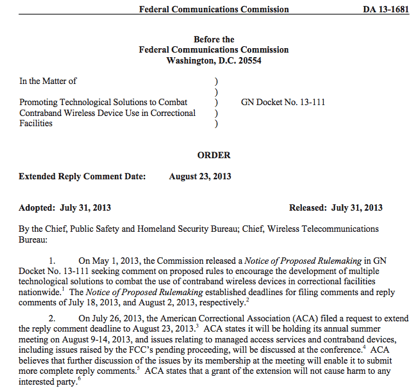
In the above order from FCC, the reply comment date for the cellphones in prison rulemaking, Docket 13-111, has been extended to August 23, 2013.
There is a lot to comment on:
- AT&T objects to requiring a carrier to terminate service to a cell phone identified being in a prison saying it will only do so with an order from FCC or a court. (Perhaps FCC could set up a website and “rubber stamp” all requests from approved prison administrators and then forward the request to AT&T?)
- Boeing states that FCC could authorize managed access in cellular spectrum “without a spectrum lease agreement” and that “reliance on lease agreements to authorize managed access systems could create undesirable precedent” (Most other commenters just believe FCC should simplify leasing and, except for MSS comments, do not suggest that leasing should be mandatory or should be on reasonable terms.)
- CTIA believes that mandatory service termination of cell phones operating in prisons can not be authorized unless FCC “adopt(s) clear, standardized requirements that apply to all cell detection systems” - a clear multiyear delay unless CTIA wants to be helpful -- as opposed to be obstructive.
- Verizon thinks service termination requests should require a court order. Heck, AT&T is more open minded and is willing to consider a request from FCC! (Sprint & T-Mo have not commented as yet.)
- NTCH, Inc. (a regional CMRS carrier that offers service under the trade name CLEAR TALK) says FCC “should declare the confines of prisons, including surrounding lands owned or controlled by the prison system, to be ‘quiet zones’ akin to the Commission's treatment of radio astronomy and other research facilities designated by the Commission…A corrections department could only declare a site a quiet zone in connection with its designation of one or more entities that would bear the expense and take the responsibility of preventing unauthorized transmissions in the prison confines and would also be in a position to offer service over authorized frequencies in the prison area…Once designated as the Prison Service Provider, the Provider would be authorized to prevent or create interference to any unauthorized transmissions from within the prison confines (including the buffer zone described below) because no such transmissions would be lawful under the terms of the licenses pursuant to which the offending cell phones would normally be operating…This plan relies on well-known quiet zone protection principles but extends not just to astronomical observations but to measures which directly protect human health and safety. The modest diminution in rights which the cellular carriers would experience under this plan is far outweighed by the benefits to the public which would result.”
- All the comments can be found at http://apps.fcc.gov/ecfs/proceeding/view?name=13-111.
vox populi, vox dei
Comments in Cellphone/Prison Rulemaking (Docket 13-111)

Carl Lackl, Jr. (l) a Baltimore witness murdered as a result of a prison cell phone call.
Capt. Robert Johnson (r) South Carolina Department of Corrections, shot 6 times
at his home as a result of a prison cell phone call.
Your blogger has filed comments in Docket 13-111, which deals with “Promoting Technological Solutions to Combat Contraband Wireless Device Use in Correctional Faciliteis (sic)”. These comments were on behalf of MSS, not for any previous or current client and were made solely in the public interest. At 34 pages without attachments they happen to be the longest filing to date, although length does not necessarily imply quality or success. So far, the docket file has 43 items from outside FCC, mostly comments
The comments start with the above photos of Carl Lackl, Jr. and Captain Robert Johnson to remind readers that unlike virtually all FCC proceedings, this one does not deal with just economic benefits for one party versus another, but rather an unintended side effect of today’s CMRS technology in which real people die.
The comments review the unusual history of this proceeding including multiple petitions that sat in “petition limbo” for years even though some were from local governments and even though Section 1.403 of the FCC’s own rules requires that such petitions be assigned a file number and “promptly “ be included on a public notice for comment. In particular, the MSS comments include as attachments parts of the 2010 GTL petition that have never been commented on that deal with mandates needed to make managed access effective in all cases and which give alternative theories that would permit the Commission the discretion to authorize jamming in special cases if it was found to be in the public interest. Cellular interests cling to an interpretation of Section 333 of the Communications Act that has never been endorsed by the FCC or a court that says FCC lacks jurisdiction to authorize jamming but NTIA has such jurisdiction for federal users.
MSS urges the Commission to require all CMRS carriers to provide the spectrum under reasonable terms needed for MAS if requested by a prison. While today’s major carriers do so and promise to pressure smaller carriers, the reality is no one knows what firms will be CMRS carriers in rural areas next year since many spectrum auctions are pending to implement the spectrum demands of cellular interests. MSS also urges the Commission to require mandatory a priori coordination of all technical changes to the cellular network near prisons with MAS systems in order to maintain the functioning of MAS throughout the network evolution.
The comments emphasize that cell phones in prisons is a complex issue and that no “magic bullet” is likely to be found that eliminates the whole problem without causing side effects. While cellular interests claim jamming would inevitably cause “overjamming” that impacts users outside prisons (see CTIA video) , their preferred “managed access systems”/MAS will also cause excess coverage in prisons that do not have an adequate buffer from publicly accessible areas, such as at Sing Sing Correctional Facility in New York.
The comments raise the issue of financing MAS or other costly solutions and points out the interrelationship between this issue and the ongoing WC Docket No. 12-375 which seeks to reduce the present high cost of inmate communication services (ICS). While cellular interests would like the state and local governments to shoulder the financial cost of exotic technology in the hostile environment of prisons, MSS points out that the carriers themselves are in a better position to handle the financial and technical burdens than prison administrators. Shifting the cost to ICS operators, as California is trying to do, may seem tempting but the inmates are truly a “captive audience” who have already been overcharged for years for telecom services. Increased contact with families can decrease recidivism -- whose costs to society and the economy dwarfs the sums involved in this issue.
The MSS comments also propose a new approach to handle contraband cell phones in prisons that deals with the special case of rural maximum security prisons - actually the location of most of the serious problems since dated suburban maximum security facilities like Sing Sing are rare now. The new approach is called “geolocation-based denial”/GBD and builds on the existing E-911 program. It is proposed that prison with a 300m buffer between secure areas and areas accessible to the general public be allowed to request the Commission to remove the secure area from the coverage of all CMRS carriers. The carriers
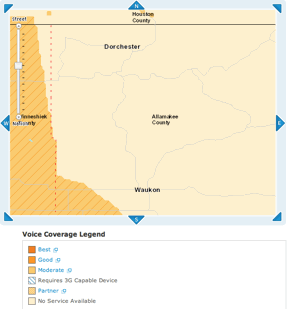
Reply comments are still open in this proceeding. vox populi, vox dei
Current ATT coverage in rural Iowa
UPDATE
FCC’s Australian counterpart, Australian Communications and Media Authority/ACMA, has a new blog entry on “Removing jammers from the streets”. Included is the above video. ACMA says
Targeting prohibited devices has demanded an agile approach to compliance. Our activities also include preventative (education/awareness) and enforcement measures. This has helped to restrict the supply of jammers to the local market, forcing consumers to turn to online sources for devices that are often seized before reaching their destination.
The Australian penalties for unauthorized jammer marketing and use are much greater than in the US. For example the blog says:
There could be more substantial penalties, such as receiving a five-year prison sentence or penalty of up to $850,000 (5,000 penalty units) for causing substantial interference to radiocommunications used by emergency services (such as fire, police and ambulance) and other special organisations. And these aren’t the only penalties that could apply.
Note from the video that ACMA, unlike the US cellular interests, is clearly able to differentiate between authorized controlled jamming in prisons and unauthorized jamming that endangers public safety. Compare this with the following CTIA video which vilified both prison jamming and unauthorized jamming based on alleged experience in Brazil.
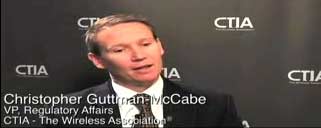
CTIA interview on prison jamming (June 2009)
UPDATE
Mr. Guttman-McCabe no longer works at CTIA and the interview on prison jamming discussed above has magically disappeared from the CTIA website. But there isn sign that CTIA's policy has changed at all.
4 Major Cellular Carriers Unite to Deter Texting While Driving
FierceWireless announced today “AT&T recruits Verizon, Sprint and T-Mobile to curb texting while driving”. AT&T started the It Can Wait website in 2012 to deter texting and driving, especially by teenagers. Sprint, T-Mo, and VZW have now joined the capping which will kick off in full on May 20. (Sprint had previously cooperated since 2010 with Oprah’s No Phone Zone website on discouraging texting use while driving.)
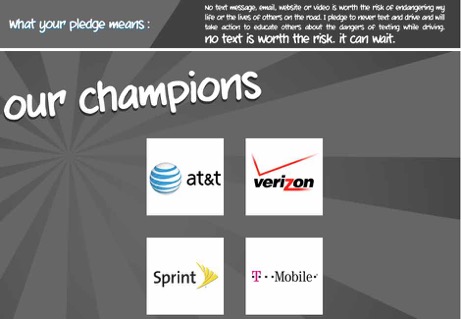
In addition, FierceWireless reports:
In conjunction with It Can Wait, smartphone manufacturers Pantech, HTC and Samsung will preload the AT&T DriveMode safety app on Android devices sold to AT&T subscribers. DriveMode automatically replies to incoming texts, notifying the sender that the message recipient is driving and unable to respond. The app automatically turns on when the user is in a vehicle moving at speeds in excess of 25 miles per hour, and it automatically shuts off once the vehicle falls to speeds below 25 miles per hour for five minutes.
Our congratulations to the 4 major carriers for joining together now in this valuable effort.
NTSB Chair Hersman
But to put this in perspective, we reported here in December 2011 a much broader recommendation from NTSB. Here is a statement from that time from NTSB Chair Deborah A.P. Hersman:
Note that this last sentence is simplified on the above industry website to just “No text is worth the risk”. The CTIA website says “The wireless industry defers to consumers and what they choose to support on driving legislation, whether that’s hands-free regulations or bans on talking on their mobile devices while driving.” Thus there still is a major gap between NTSB and the wireless industry, but the recent move is a positive step forward."According to NHTSA, more than 3,000 people lost their lives last year in distraction-related accidents. It is time for all of us to stand up for safety by turning off electronic devices when driving.
No call, no text, no update, is worth a human life.”
Some Possible New Year's Resolutions for the Cellular Industry
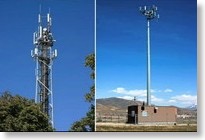
As we approach the New Year, here are some constructive suggestions for the cellular industry to think about as New Year’s resolutions. Long time readers will recognize that many have been discussed before in other contexts. Let me state first that I am a long time admirer of the cellular industry, its dynamic growth, and its general record of technical innovation. The cellular industry has also done much to improve public safety through its support for E-911, Amber Alerts, and programs to provide cell phones for domestic violence victims. But this industry has several blind spots as it has accumulated political power and FCC influence comparable to the power formerly held by entities such as the pre-divestiture AT&T, NAB, or the pre-1990 Motorola. sic transit gloria mundi
The purpose of this post is to point out constructively some of these blind spots that appear not to be in basic conflict with the fundamental goals of the industry in the hope that they may reconsider their positions in at least some of these areas. I note that while the main cellular players once were in strong opposition to the bidirectional amplifier/BDA issues now in Docket 10-4, they have moderated their position and appear to be working with responsible BDA manufacturers on technical standards for BDAs that control interference. I hope that similar reexamination is possible in the areas below:
1. Wireless technology innovation. The focus of the cellular industry is that innovation is good, but that the key to innovation is more licensed spectrum for their industry. They are happy with the current level of regulation so everyone should be also. This is clear from CTIA’s comments and reply comments in the Wireless Innovation NOI. They see no need to expedite deliberations of new technology, saying “Simply put, even for good ideas with broad appeal, resolution unfortunately can take a long time notwithstanding the desire of parties to speed the process along”. The fact that the endless drawn out FCC spectrum deliberations stifle capital formation for technical innovators is no concern for mainstream CMRS players with positive cash flow.
But Qualcomm was once a startup in an era when it got its key regulatory decision in 2 years after formation. The CDMA technology that this startup pioneered supplies a major fraction of the 2G market (VZW and Sprint) and is the core of all world’s 3G systems. But this type of disruptive wireless innovation os getting to be impossible due to regulatory stagnation but for the cellular industry and for other spectrum users that compete for cross elastic spectrum. Sadly, the cellular industry is firm with the status quo here.
Wa - harmony (Japanese)

What is the industry doing about this? Are they trying to increase sidetone levels so people don’t shout when using cell phones? Are they trying to make it easier to switch the ringer to a vibrate only/ “manners mode” as in Japan where all carriers have voluntarily agreed that a press of the “#” key toggles the unit to and from vibrate only mode? Are they researching ways for theaters and restaurants where people really want a semblance of quiet to use Bluetooth or a similar link to switch phones automatically to vibrate only? Kudos to Motorola for inviting Dr. Norman to talk on this issue. How much of this type of dialogue is going on now in the industry?
UPDATE
Suggested reading for cellular industry managers: “Wild Night at Philharmonic After Phone Interruption” describing a January 10 incident “in one of the quietest parts of the final movement of a gorgeous New York Philharmonic performance of Mahler's Ninth”.
3. Cell phones use in vehicles. Technology should improve life, not threaten it. In September 2011 NTSB recommended a ban on cell phone use in commercial vehicles (trucks and buses) after investigation of a Kentucky crash that killed 11 people. The industry was silent except for an e-mail message to your blogger saying “The wireless industry … does not oppose legislation that restricts the use of wireless communication by drivers." (This quote was never printed or posted anywhere else as far as can be determined.)
Then in December 2011 NTSB recommended to “ban the nonemergency use of portable electronic devices (other than those designed to support the driving task) for all drivers”. This time CTIA was no longer silent, saying “ As far as talking on wireless devices while driving, we defer to state and local lawmakers and their constituents as to what they believe are the most appropriate laws where they live.” This is not leadership, this is non opposition. If I was involved in a product or service that resulted in death on a regular basis as an unintended byproduct I would be a lot more concerned. Especially since talking in cars is not the main use of cell phones.
The NTSB recommendations are not perfect. For example they do not deal with new technology since all NTSB can do is investigate past accidents. Why doesn’t the industry do something more proactive like start a standards committee, or encourage DOT to start one, that can certify which technologies are safe enough for use in vehicles?
(But kudos to Sprint for breaking with the crowd and being a cosponsor of Oprah’s Oprah’s No Phone Zone website and its “No Phone Zone Pledge”.)
4. RF safety. Most of the cellular industry thinks that the public should be happy with their statements that cellphones meet FCC standards and are therefore safe. A decade ago, the industry fought FCC over the proposal to stop hiding SAR ratings for cell phone models in an obscure unmanageable database. As a previous blog post here has as a headline, “CTIA: Maybe Your RF Safety PR Strategy Isn't Working?” The past year has seen CTIA boycott San Francisco and got to court (with an initial partial victory) over a local ordinance requiring point of sale disclosure of SAR data. (The same data that Verizon Wireless openly discloses on their website for models they sell.)
Perhaps the industry does not want you to know about the secret of OETB65C. Stalin once said, “The people who cast the votes decide nothing. The people who count the votes decide everything.” So the SAR standards for cellphones in Sections 2.1091 and 2.1093 were subject to a notice and comment rulemaking that made 1.6 W/kg the SAR limit. But how is that really determined? In practice through the procedures of OETB65C which gives the manufacturers a lot of leeway as to what spacing from the simulated body they can use for measurements in the body, even if they do not provide a holder that would implement that distance and even if they don’t warn users not to put the device in their pocket. Both Time magazine and your blogger have written about this issue, but there seems denial at both FCC and industry on the issue.
There is no proof that cell phone radiation is dangerous. Indeed, some of the brain cancer claims made as clearly outrageous. (Considering there is no proof that cell phone radiation causes any pathology, why the focus on brain cancer - except that it is a very scary diagnosis.) But the web site of CTIA’s French counterpart is a lot more pragmatic than US industry sites on the risks and unknowns as well as the fact that some users may want to take extra precautions. The Swiss counterpart of EPA also has a site with pragmatic and practical information lacking in industry and government sites in the US.
5. Base stations and their environments. One of the issues driving the need for more CMRS spectrum is the difficulty of building base stations, particularly in suburban areas. Cellular capacity is a function of 3 factors: technology (e.g. 3G vs. 4G), infrastructure (number and nature of base stations, and amount of spectrum. Limits on one factor press demand on the others. For 2 decades industry has pressed Congress and FCC to limit the ability of local governments to control base station deployments with limited success. The reason is simple for the limited progress; as Tip O’Neill said famously, “All politics is local”. As long as base station designs “look like they are designed by engineers” with no regards for their surroundings in most cases, the neighbors will object.
This month’s IEEE Spectrum reports on a UK design contest for power pylons sponsored by a major electric utility, a national government agency, and the architect’s professional society, which resulted in several novel designs including the one above. Why can’t the US cellular industry help sponsor a similar contest for bold new ideas in base station design? The cost would be small compared to what they are spending on they lobbying war with the broadcasters as present.
6. “Spectrum scoring” or “How to count to 500”. The cellular industry originally demanded 800 MHz of new spectrum for CMRS although they are now accepting of the 500MHz NBP goal. But what spectrum counts towards the 500 MHz goal? Does every single Hertz have to be only in spectrum that meets standards developed in Europe to be manufactured in China? There are many types of wireless innovation other than making iPhone and iPad clones. Some of them involve using spectrum more efficiently. The focus on meeting international standards means that only innovators who want to plow through the complex international standards process can get market access in the US. Actions like PacTel’s decision to go with CDMA in the 1980s apparently is beyond consideration now.
While your blogger has no views against giving more spectrum to CMRS, many of us think the 500 MHz goal is impossible under the conditions for “counting” that the cellular industry has implicitly set with factors like nationwide 24/7 1000 ms/s access and in 3GPP specified bands. Although LTE systems can use unpaired spectrum, most of the spectrum on their wish list appears to be paired and symmetric. If FCC and NTIA come up with spectrum that doesn’t that meets all these criteria, does it “count”?
7. Provide communications for niche applications that otherwise contend for spectrum with CMRS. After the success of the iPhone, the CMRS focus seems to be on “killer apps”/knock out new products. Niche markets are of little or now interest unless they can be served with apps on standard hardware. Who needs little $100M markets. This is understandable from the MBA viewpoint.
But here is another viewpoint: Some niche markets compete for spectrum at FCC that is the same or comparable spectrum to what the cellular industry seeks. For example the medical community is clearly seeking more spectrum for short range applications. It is clear to many of us, even some in FCC, that the existing use of wireless microphones in UHF TV band “white space” is not sustainable in the long term except perhaps for uses involving only a few microphones like small churches and conference rooms - not theaters and major concerts. This is because of cellular industry pressure for UHF incentives auctions that will eventually tie up the same spectrum.
In the past, there was no alternative for the CMRS industry to serve these and other wireless niches. However, with the spectrum leasing provisions of Subpart X of Part 1 and today’s femtocell technology it is possible for cellular carriers to lease short range spectrum to users with other than standards cellular modulations/physical layers and without connection to the public network. A good example is the Qualcomm FlashLinq™ technology that will allow users to connect directly to each other with non standards modulations on spectrum leased from and under the control of a CMRS carrier. Maybe the specifics of FlashLinq™ are not perfect for the CMRS community, but it clearly shows the feasibility of new types of spectrum use in CMRS spectrum. Even if it is not a billion dollar market, its ability to “soak up” other spectrum uses that would otherwise compete for spectrum might make it attractive to openminded CMRS firms.

Until recently, the largest prepaid operator, TracFone, allowed users to activate a phone bought anonymously and “skip” the step to report name and address. However, the option of buying with cash bagfuls of prepaid phones at Walmart, activating them over the web with a false name and address, and selling them for criminal use is still quite real. Isn’t it odd that we more concerned about over-the-counter sales of Sudafed and Plan B than we are about bagfuls of anonymous cellphones?
Many countries require some identification before prepaid phones can be activated. This is a complex issue both because of the size of the market and the appeal of prepaid phones to market sectors who need them for legitimate economic and safety-related reasons but, as we know from the voter ID controversy, may lack or be unwilling to identify themselves in the standard ways. While I sincerely hope we never have a cellphone-related IED attack in this country, such an event would force a PATRIOT Act-like knee jerk reaction that could be more draconian that a deliberate process now to address the situation.
UPDATE
For those of you who wonder about the temerity of an industry outsider raising such questions about the cellular industry, let me point out the Verizon $2 “payment fee“/“convenience charge” kerfuffle that started just as this blog was first posted and ended a day later. Clearly, VZW, the largest cellular carrier in the US was out of touch with its customers on this issue and had to beat a hasty retreat. Perhaps the industry is also out of touch on the above issues?
UPDATE 2
On 1/7/12 CNN posted an article by bestselling author Bob Greene entitled “Is 2012 the year to hang up the phone?”
Story highlights:
There is growing chorus of officials, employers urging less cell phone useHe says NTSB warns against use in cars; bosses pushing back on personal calls at workHe says cell-phone distractions even affect surgeons and nurses; cut productivityIt may be impossible to take people's freedom of cell use away from them
So your blogger is not the only one seeing cell phone use backlash. Perhaps if the industry was more sensitive to the concerns listed above it might be in their own interest?
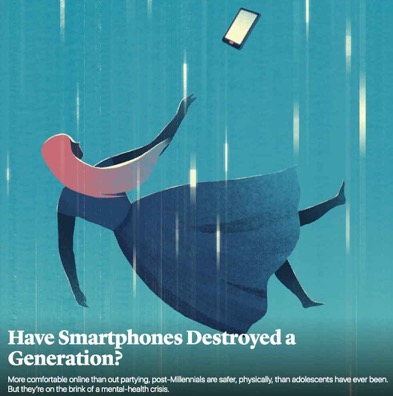
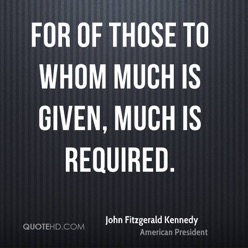
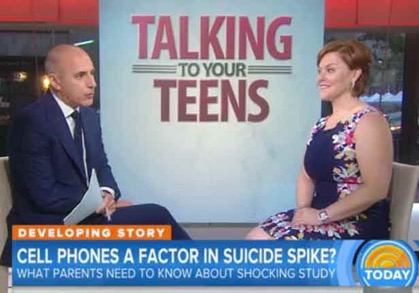

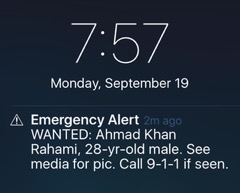
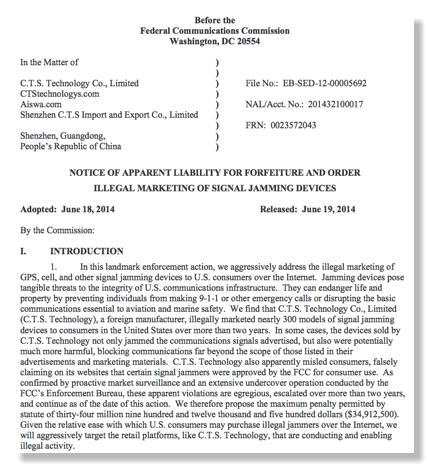

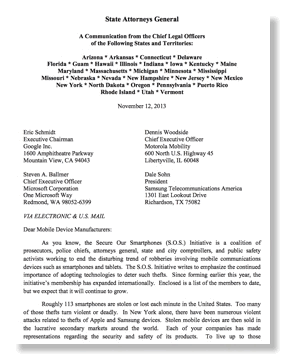
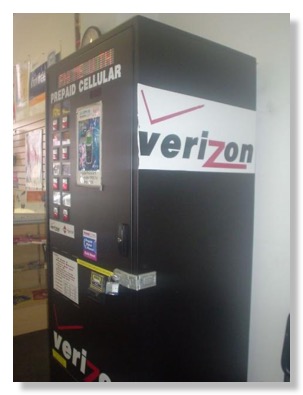
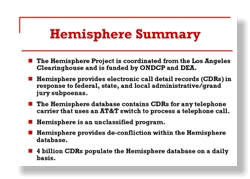



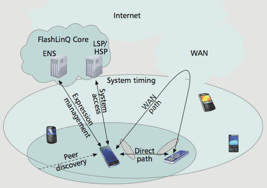



![Validate my RSS feed [Valid RSS]](valid-rss-rogers.png)

